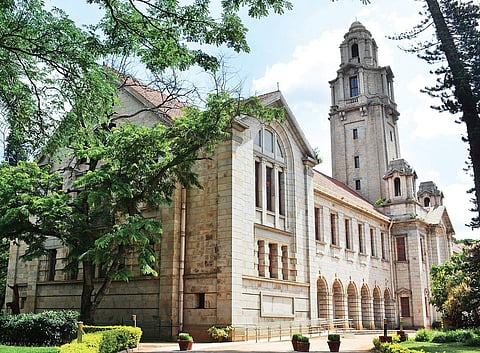

BENGALURU:The Indian Institute of Science (IISc), Bengaluru, popularly called TATA Institute, was conceived as a 'research institute' or 'university of research' by the visionary Parsi businessman Jamsetji Nusserwanji Tata, towards the end of the 19th Century.
The early history of the institute is a fascinating chapter in the story of higher education and scientific research in India, which led to the establishment of the institute. The key figures include the founder – Jamsetji Nusserwanji Tata, a far-sighted visionary; Swami Vivekananda; Nalavadi Krishnaraja Wadiyar, the then Maharaja of Princely Mysore and his mother Her Highness Kempananjamani Vanivilasa Sannidhana, then Queen Regent; Lord Curzon, former Viceroy of India; and Burjorji J Padshah, Tata’s right hand man.
The institute came into being on the issuance of the Vesting Order on May 27, 1909, by the British government after a long gestation period of thirteen years, since it was first conceived in 1896. The 400-acre land for the institute was generously donated by the Maharaja of Mysore in March 1907. The contribution from the princely state of Mysuru was one of the decisive factors in determining the location of Tata’s proposed institute in Bengaluru. Mention must be made of the contribution by Dewan K Seshadri Iyer, who ably assisted the Maharaja on this issue. Among the many factors that favoured Bengaluru for the establishment of the institute were its salubrious climate, availability of abundant natural mineral resources and unlimited power from the Shivasamudaram Power Station.
Tata did not want his name to be associated with the institute, his dream was to create an institution that would contribute to the development of India. Nevertheless, over the years, the locals have fondly call IISc, the TATA Institute, in honour of its founder. A silken connection to Bengaluru and IISc was established early in its history when the elder son of Tata, Dorab married a Bengalurean Meherbai, the daughter of HJ Bhabha, the then inspector general of education for Mysuru and Coorg.
*BWSSB outcome of research at IISc*
The Institute began with two departments - the general and applied chemistry department and the electro-technology department - and the first batch of students were admitted into the institute in 1911-1912. Soon, the departments of organic chemistry and biochemistry were added. Early research work in these departments focused on several local industrial problems, such as sandalwood oil extraction and lac and acetone manufacturing processes. Records available at the IISc Archives and Publications Cell show that the Bangalore Water Supply and Sewage System (BWSSB) was the outcome of research work carried out in the 1920s by Professor Gilbert J Fowler of the biochemistry department. The department of physics came into being in 1933 when Professor CV Raman became the first Indian director of IISc.
The institute is today ranked as the number one institute in the country. Several new areas of research have been established. The institute’s departments, in fields ranging from aerospace engineering and high voltage engineering, biochemistry and many more, have served to nucleate several organisations/institutions in both the public and private sectors in the country. The faculty and alumni of the institute have been at the forefront of establishing and spearheading many new institutions and programmes across India. Homi Bhaba conceived the idea of the Tata Institute of Fundamental Research (TIFR) while working at IISc. Vikram Sarabhai, the founder of India’s Space Programme, collaborated with CV Raman at IISc. The Central Power Research Institute (CPRI), Bengaluru; the Hindustan Aeronautics Limited (HAL); the National Aerospace Laboratory (NAL); the Central Food and Technological Institute (CFTRI-Mysore); the Karnataka Soaps and Detergents Limited are some of the other organisations that owe their origin to the institute.
Professor P Balaram, the former director of IISc, had written in the journal Current Science (Vol 94, No, 10 Jan 2008) and was quoted in editorial, 'The Birth of the Indian Institute of Science' reading, ”The story of IISc and the men who built it is yet to be written. If the right scribe is found, it should be a tale worth reading.”
- The author is a technical officer, retired, Archives and Publications Cell, IISc
Prominent personalities who served IISc
Over the past 100 years, several prominent citizens of the city have served in an official capacity as IISc’s governing bodies. They include Dewan’s – T Anand Rao, VP Madhava Rao, Sir Mirza Ismail and Sir M Vishveswaraya. Many of India’s most distinguished scientists have been associated with IISc. Notable among them are GN Ramachandran, Harish Chandra, Satish Dhawan, Arcot Ramachandran, Roddam Narasimha and CNR Rao.
New academic programmes
In the last decade, IISc has initiated many new academic programmes such as the interdisciplinary PhD programmes in mathematical sciences, chemical biology, earth and nano science and technology. An M Tech programme in climate sciences and climate change has also been established.